The Shakespeare Collection
October 3, 2013
Description by Margo Kolenda, undergraduate student in English, Hispanic Studies and Comparative Literature
 The Shakespeare Collection held by the Robert D. Farber University Archives and Special Collections Department consists of two separate acquisitions, each astounding in its own right. In December of 1961, Allan Bluestein, a member of the book-collecting philanthropic club, The Brandeis Bibliophiles, donated what is perhaps the most brilliant gem in the collection: a First Folio edition of Shakespeare’s works from 1623. To underscore the rarity of this treasure, fewer than 240 copies of the First Folio are known to exist today, and roughly one-third of these are in the Folger Shakespeare Library [1]. Bluestein also donated a copy of the Second Folio and a Fourth Folio; another Fourth Folio was donated by Henry and Hannah Hofheimer. In addition to these materials, the Baldwin Shakespeare Collection—the core of which was acquired from Ruth M. Baldwin of the Baldwin Library, University of Florida, combined with other Shakespeare gifts and purchases—includes many rare and fascinating editions, compilations and critical material from the Renaissance through the early 20th century. The entire Shakespeare collection at Brandeis consists of the four Folios mentioned, 74 copies of single plays, 119 editions of multiple “complete” works, 13 works of his poetry, 1 special edition DVD and 58 critical, analytical, descriptive, illustrative or other works.
The Shakespeare Collection held by the Robert D. Farber University Archives and Special Collections Department consists of two separate acquisitions, each astounding in its own right. In December of 1961, Allan Bluestein, a member of the book-collecting philanthropic club, The Brandeis Bibliophiles, donated what is perhaps the most brilliant gem in the collection: a First Folio edition of Shakespeare’s works from 1623. To underscore the rarity of this treasure, fewer than 240 copies of the First Folio are known to exist today, and roughly one-third of these are in the Folger Shakespeare Library [1]. Bluestein also donated a copy of the Second Folio and a Fourth Folio; another Fourth Folio was donated by Henry and Hannah Hofheimer. In addition to these materials, the Baldwin Shakespeare Collection—the core of which was acquired from Ruth M. Baldwin of the Baldwin Library, University of Florida, combined with other Shakespeare gifts and purchases—includes many rare and fascinating editions, compilations and critical material from the Renaissance through the early 20th century. The entire Shakespeare collection at Brandeis consists of the four Folios mentioned, 74 copies of single plays, 119 editions of multiple “complete” works, 13 works of his poetry, 1 special edition DVD and 58 critical, analytical, descriptive, illustrative or other works.
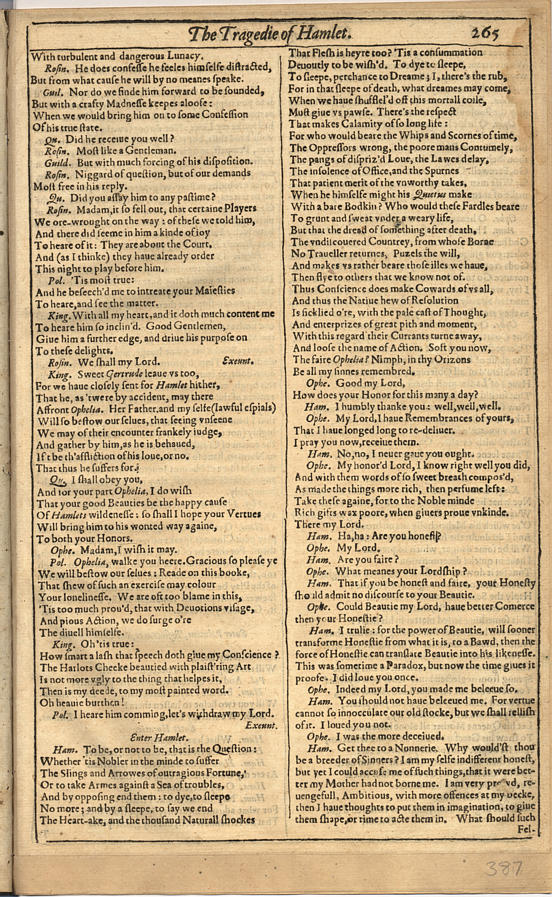 William Shakespeare lived from about 1564-1616, so our earliest acquisition, the First Folio, was created 7 years after his death and 12 years after the first recorded performance of his last play, The Tempest. The First Folio was printed in London by Isaac Jaggard and Ed. Blount [2]. Historically, this represented the first time theatrical work was compiled and released in such a way to the public, an immense milestone and an indicator of Shakespeare’s popularity even at the time. The cover includes an engraved portrait by Martin Droeshout and represents the first inclusion of Shakespeare’s portrait in his work. The physical Folio is impressive to behold, especially as it has been unbound for preservation reasons: those interested in the process of bookbinding may view the oversewn tracks in the paper.
William Shakespeare lived from about 1564-1616, so our earliest acquisition, the First Folio, was created 7 years after his death and 12 years after the first recorded performance of his last play, The Tempest. The First Folio was printed in London by Isaac Jaggard and Ed. Blount [2]. Historically, this represented the first time theatrical work was compiled and released in such a way to the public, an immense milestone and an indicator of Shakespeare’s popularity even at the time. The cover includes an engraved portrait by Martin Droeshout and represents the first inclusion of Shakespeare’s portrait in his work. The physical Folio is impressive to behold, especially as it has been unbound for preservation reasons: those interested in the process of bookbinding may view the oversewn tracks in the paper.
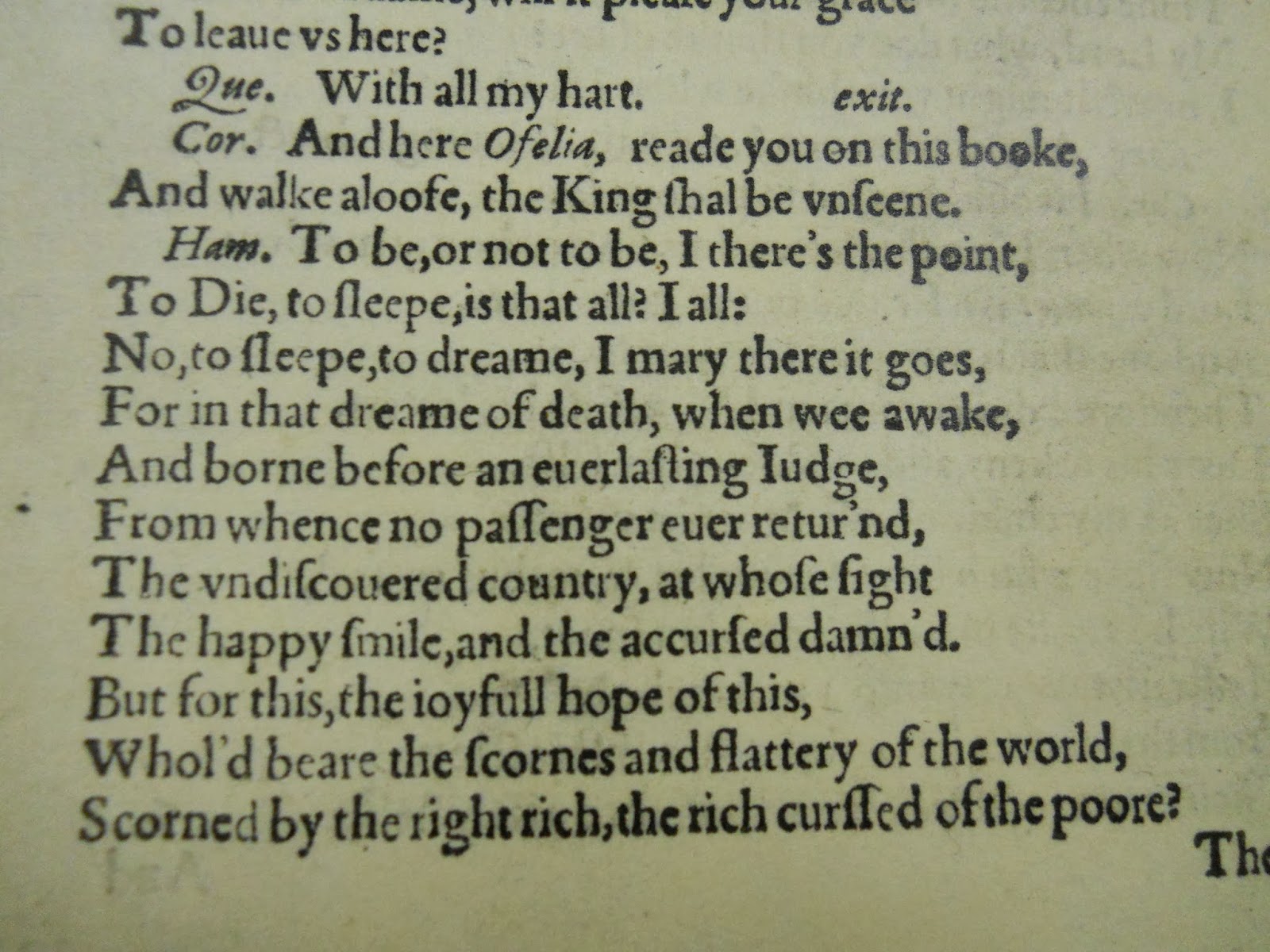 The First Folio and subsequent folio editions divide Shakespeare’s plays into three categories: comedies, histories and tragedies. Today many scholars and anthologies include a fourth category, “romances”; however, the original designations are still retained in the Norton Shakespeare, as well as other editions published today. In the Folio, while the plays have been analyzed enough to group them categorically, they are not presented to the reader in a chronological or thematic order. This indicates that while contemporaneous readers to Shakespeare thought the “type” of play to be important, they did not seek any sort of larger picture from his canon. Notably, two plays, “Pericles, Prince of Pyre” and “The Two Noble Kinsmen,” have been omitted, but are included in modern collections. This may be due to a strict adherence on the part of the Folio editors to include only work certain to be penned by Shakespeare or without collaboration from other playwrights [3].
The First Folio and subsequent folio editions divide Shakespeare’s plays into three categories: comedies, histories and tragedies. Today many scholars and anthologies include a fourth category, “romances”; however, the original designations are still retained in the Norton Shakespeare, as well as other editions published today. In the Folio, while the plays have been analyzed enough to group them categorically, they are not presented to the reader in a chronological or thematic order. This indicates that while contemporaneous readers to Shakespeare thought the “type” of play to be important, they did not seek any sort of larger picture from his canon. Notably, two plays, “Pericles, Prince of Pyre” and “The Two Noble Kinsmen,” have been omitted, but are included in modern collections. This may be due to a strict adherence on the part of the Folio editors to include only work certain to be penned by Shakespeare or without collaboration from other playwrights [3].
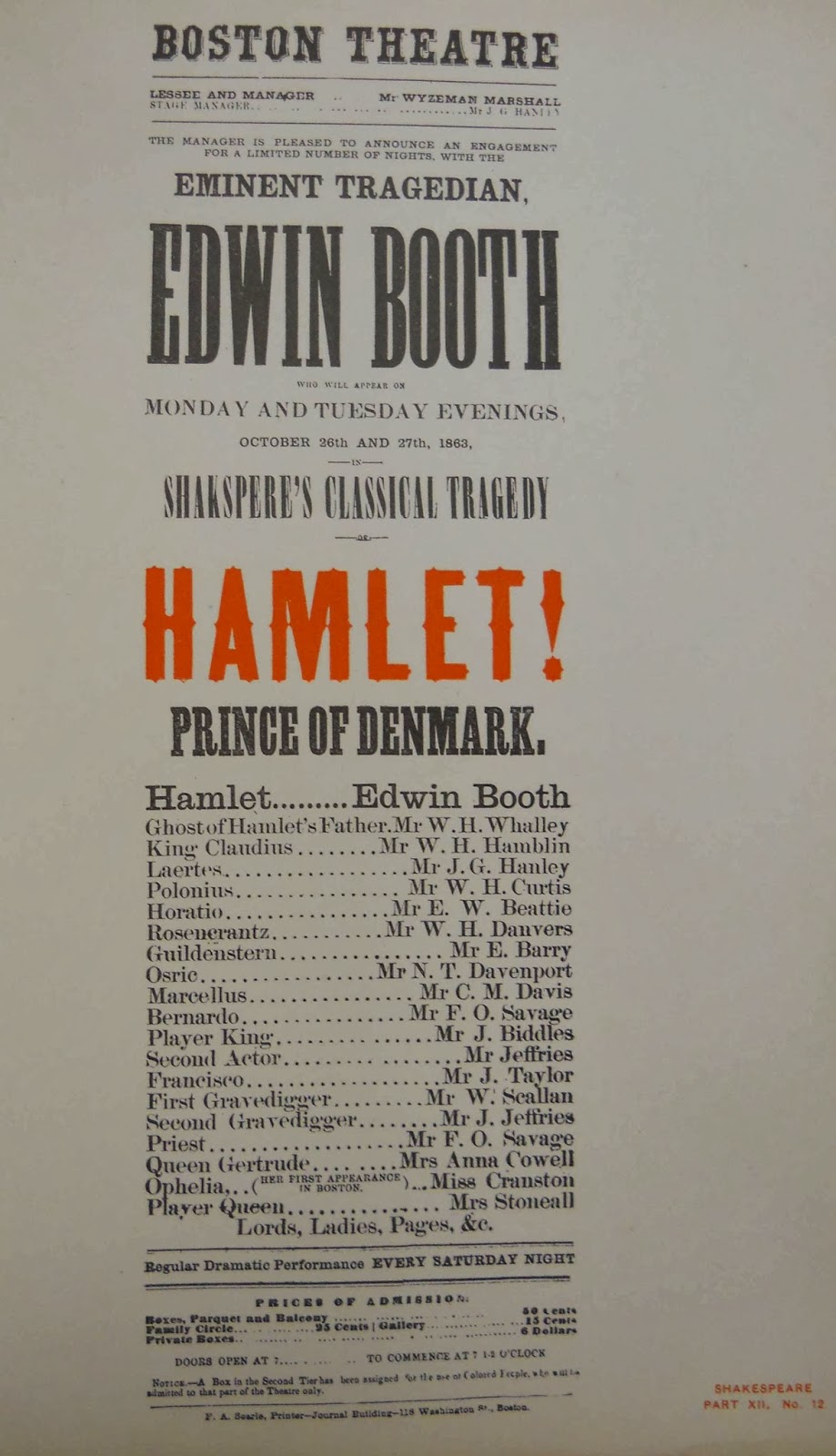 One of the most significant issues with Renaissance drama, particularly that of Shakespeare, and one of the major reasons a collection such as this one is so important, is the question of reliability. Shakespeare himself wrote down the plays only to hand to the actors, and never compiled or revised his works in the polished manner that later came into style and is today the norm. Shakespeare had no true ownership over his works: they became the property of the theatrical company, and were not circulated due to fear of rival companies’ potential profit [4]. Oftentimes the versions that were recorded into Quartos and Folios were written down by audience members and subject to individual nuances or mistakes. Thus, even two citizens attending the same showing of “Hamlet” could provide two slightly different versions of the play. The show might change slightly from performance to performance, and there was always a chance that the actors would introduce a variance from Shakespeare’s texts [5]. The very titles of some of the works reflect this multiplicity; for example, the collection includes one edition of “Henry IV” that carries the very specific title “King Henry IV: with the humours of Sir John Falstaff; a tragi-comedy; as it is acted of the theatre in Little-Lincoln’s-Inn-Fields by His Majesty’s servant; revised, with alterations,” noting the exact live version from which it arose, emphasizing its difference from another version at a different theater [6]. It is therefore truly impossible to create an edition that matched what initially emerged from the pen of Shakespeare and was first presented to his peers.
One of the most significant issues with Renaissance drama, particularly that of Shakespeare, and one of the major reasons a collection such as this one is so important, is the question of reliability. Shakespeare himself wrote down the plays only to hand to the actors, and never compiled or revised his works in the polished manner that later came into style and is today the norm. Shakespeare had no true ownership over his works: they became the property of the theatrical company, and were not circulated due to fear of rival companies’ potential profit [4]. Oftentimes the versions that were recorded into Quartos and Folios were written down by audience members and subject to individual nuances or mistakes. Thus, even two citizens attending the same showing of “Hamlet” could provide two slightly different versions of the play. The show might change slightly from performance to performance, and there was always a chance that the actors would introduce a variance from Shakespeare’s texts [5]. The very titles of some of the works reflect this multiplicity; for example, the collection includes one edition of “Henry IV” that carries the very specific title “King Henry IV: with the humours of Sir John Falstaff; a tragi-comedy; as it is acted of the theatre in Little-Lincoln’s-Inn-Fields by His Majesty’s servant; revised, with alterations,” noting the exact live version from which it arose, emphasizing its difference from another version at a different theater [6]. It is therefore truly impossible to create an edition that matched what initially emerged from the pen of Shakespeare and was first presented to his peers.
For the modern scholar, this translates into a great variance in editions and the necessity to compare multiple versions. Most printed versions today indicate the source text or texts and typically include either an introduction or notes justifying the choices made. The implications of variance between editions cannot be overemphasized. Small changes in wording can result in large differences in meaning, and many small differences add up to interpretations of the text that are still highly debated almost 400 years after Shakespeare’s death. Some variations are aesthetic, some are more likely what Shakespeare intended given a close analysis of his style and some cause schisms in the academic community that can redefine entire works. Even the most famous lines have multiple versions, as shown in the two versions (one from the First Folio (left) and one from the First Quarto (right)) of Hamlet’s famous soliloquy [7].
The texts in Brandeis’ Shakespeare collection reflect this preoccupation with reliability, with some texts even questioning Shakespeare’s authorship. As mentioned earlier, the First Folio abstains from including two works that later research attributes to Shakespeare. Even the title page of the First Folio emphasizes veracity, including in its titular subheading the phrase “published according to the true originall copies” [8]. Later publications include such announcements in their titles as “revised and corrected” [9], and boast both the newest interpretation and the oldest source. The texts typically emphasize their dominance over other versions by presenting a “truer” version, but the ability to assert such claims rests on the uncertain ground of what can properly be called “Shakespearian.”
 One of the most sensational parts of the Shakespeare Collection is the play Double falshood; or, The distrest lovers. A play, as it is acted at the Theatre-Royal in Drury-Lane. Written originally by W. Shakespeare; and now revised and adapted to the stage by Mr. Theobald, the author of Shakespeare restor’d [10]. Brandeis’ Shakespeare collection includes 3 copies of this rare work, published in 1728. To paraphrase the wordy title, “Mr. Theobald” presents to the public a work based on a play of Shakespeare, which is now lost if the claim holds true. While Mr. Theobald introduces his work in such a way as to make the authorship ambiguous, the plot and style of Double Falsehood does not correlate with Shakespeare’s style [11]. However, the idea of a source text in a lost work of Shakespeare’s is not unreasonable, and a suspected play titled The History of Cardenio has been cited as a possible “lost play” in addition to others such as Love’s Labour Won [12]. Cardenio has been suspected to have been based on a character in Cervantes’Don Quixote; indeed, the characters in Double Falsehood all sport Spanish names, and the setting is Seville [13]. Scholars disagree on the veracity of Mr. Theobald’s claims; many write off the original authorship as a ploy to gain an audience on the part of Theobald, while the Arden Shakespeare went so far as to publish Double Falsehood as part of its Shakespeare series in 2010.
One of the most sensational parts of the Shakespeare Collection is the play Double falshood; or, The distrest lovers. A play, as it is acted at the Theatre-Royal in Drury-Lane. Written originally by W. Shakespeare; and now revised and adapted to the stage by Mr. Theobald, the author of Shakespeare restor’d [10]. Brandeis’ Shakespeare collection includes 3 copies of this rare work, published in 1728. To paraphrase the wordy title, “Mr. Theobald” presents to the public a work based on a play of Shakespeare, which is now lost if the claim holds true. While Mr. Theobald introduces his work in such a way as to make the authorship ambiguous, the plot and style of Double Falsehood does not correlate with Shakespeare’s style [11]. However, the idea of a source text in a lost work of Shakespeare’s is not unreasonable, and a suspected play titled The History of Cardenio has been cited as a possible “lost play” in addition to others such as Love’s Labour Won [12]. Cardenio has been suspected to have been based on a character in Cervantes’Don Quixote; indeed, the characters in Double Falsehood all sport Spanish names, and the setting is Seville [13]. Scholars disagree on the veracity of Mr. Theobald’s claims; many write off the original authorship as a ploy to gain an audience on the part of Theobald, while the Arden Shakespeare went so far as to publish Double Falsehood as part of its Shakespeare series in 2010.
The most fascinating aspects of Double Falsehood lie not within the actual possibility of Shakespearian authorship but what it means for a playwright to claim such an ancestry for his work. Attaching the single word “Shakespeare” to a text almost guaranteed interest, and the popularity of the playwright is obvious when one considers closely the items in Brandeis’ Shakespeare collection. The plays of Shakespeare were not only popular in the theater, but were so desired that people wanted to have a physical copy. This prompted the printing of the First Folio, an immense amount of work for the printer and not a luxury every home could afford. Furthermore, Shakespeare’s popularity was such that hundreds of versions could be sold, with new editions appearing continually. Even great authors in their own right felt it necessary to dwell on Shakespeare’s works—Brandeis holds several editions edited by Alexander Pope [14].
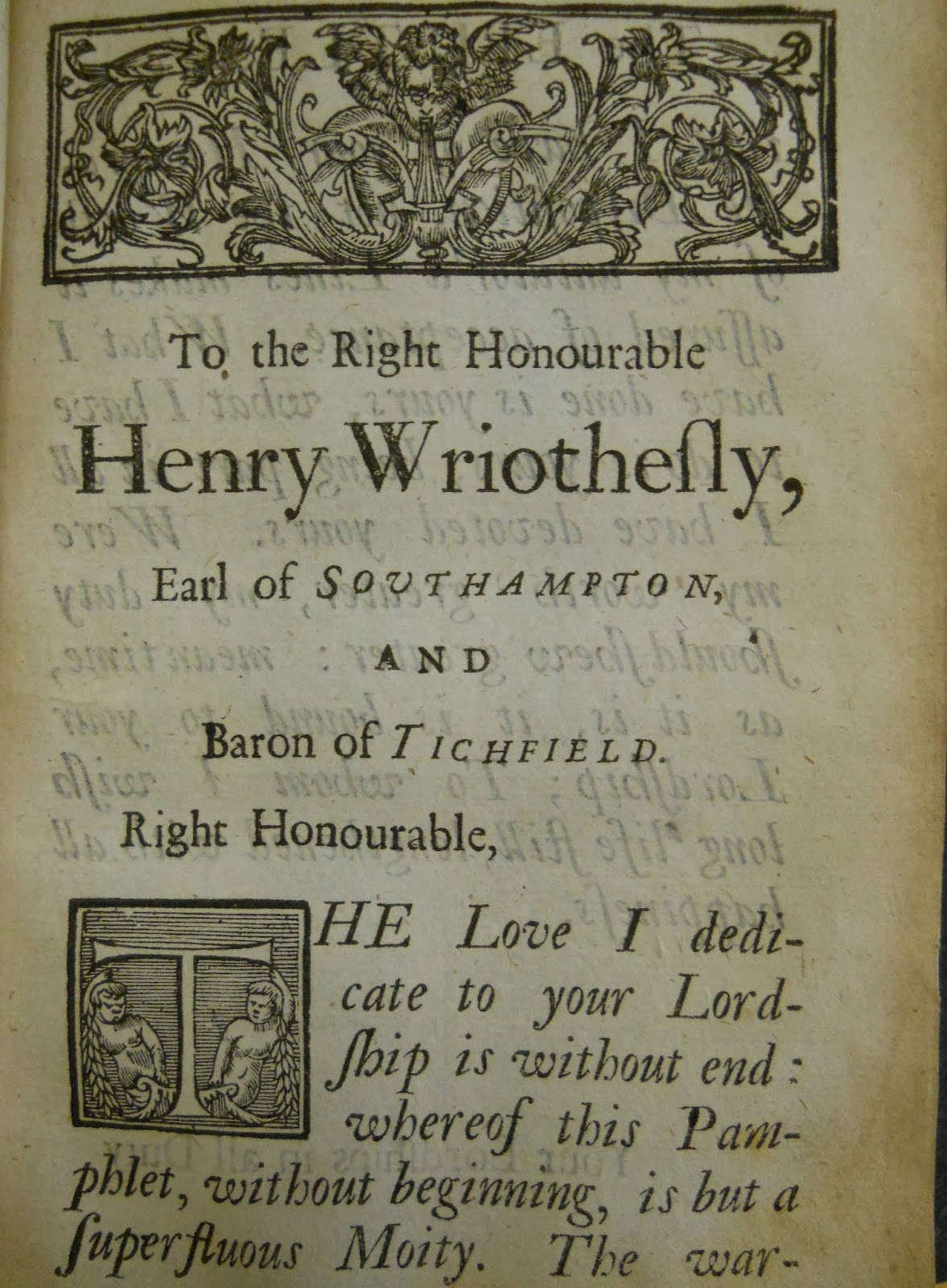 The variety of methods in presenting Shakespeare is almost as large as the collection itself. The range of texts available grants insight into Shakespeare’s works and his popularity, but also into publishing trends in general over the four centuries the collection spans. A 1709 six-volume set introduces the idea of looking at the author alongside the works by including biographical text [15]. Soon after, in Mr. Theobald’s 1740 edition, “critical” material is included, although the term certainly does not match up to today’s analyses [16]. Divisions began to emerge in the trajectory of texts, as some “early editions” began to be revised in their own right rather than turning to the originals; a 1745 edition announces its source as that edited by Pope [17]. Soon after, editions begin to include the opinions of their editors, a step towards modern criticism. Shakespeare’s status was quickly classicized, and in 1752, little more than a century after his death, The Beauties of Shakespeare was published; this reference work functions as a database of Shakespearian quotes, treating them as commonly known maxims [18]. Other works in the collection compare similar passages of Shakespeare, in addition to offering explanations, and rearrange his material in a variety of fascinating fashions [19]. Finally, in 1765, Zachary Grey’s Critical, Historical, and Explanatory Notes on Shakespeare offers a modern reader a view into the analytical sphere of the 18th century. Grey’s work goes play by play, commenting on the allusions within the play, a foundational text for later critics and analysts to build upon [20]. It includes a five-page “explanation of the old words used by Shakespeare in his works,” which many scholars and students today might still find helpful. This glossary attests to Shakespeare’s contribution to the English language, as a number of words included have been incorporated into our common vocabulary (“dank” for moist, “dumps” for melancholy (think: down in the dumps), “moody” for angry, “sheen” for shine, etc.), and it is texts like Grey’s that demonstrate these current definitions as novel creations of the playwright.
The variety of methods in presenting Shakespeare is almost as large as the collection itself. The range of texts available grants insight into Shakespeare’s works and his popularity, but also into publishing trends in general over the four centuries the collection spans. A 1709 six-volume set introduces the idea of looking at the author alongside the works by including biographical text [15]. Soon after, in Mr. Theobald’s 1740 edition, “critical” material is included, although the term certainly does not match up to today’s analyses [16]. Divisions began to emerge in the trajectory of texts, as some “early editions” began to be revised in their own right rather than turning to the originals; a 1745 edition announces its source as that edited by Pope [17]. Soon after, editions begin to include the opinions of their editors, a step towards modern criticism. Shakespeare’s status was quickly classicized, and in 1752, little more than a century after his death, The Beauties of Shakespeare was published; this reference work functions as a database of Shakespearian quotes, treating them as commonly known maxims [18]. Other works in the collection compare similar passages of Shakespeare, in addition to offering explanations, and rearrange his material in a variety of fascinating fashions [19]. Finally, in 1765, Zachary Grey’s Critical, Historical, and Explanatory Notes on Shakespeare offers a modern reader a view into the analytical sphere of the 18th century. Grey’s work goes play by play, commenting on the allusions within the play, a foundational text for later critics and analysts to build upon [20]. It includes a five-page “explanation of the old words used by Shakespeare in his works,” which many scholars and students today might still find helpful. This glossary attests to Shakespeare’s contribution to the English language, as a number of words included have been incorporated into our common vocabulary (“dank” for moist, “dumps” for melancholy (think: down in the dumps), “moody” for angry, “sheen” for shine, etc.), and it is texts like Grey’s that demonstrate these current definitions as novel creations of the playwright.
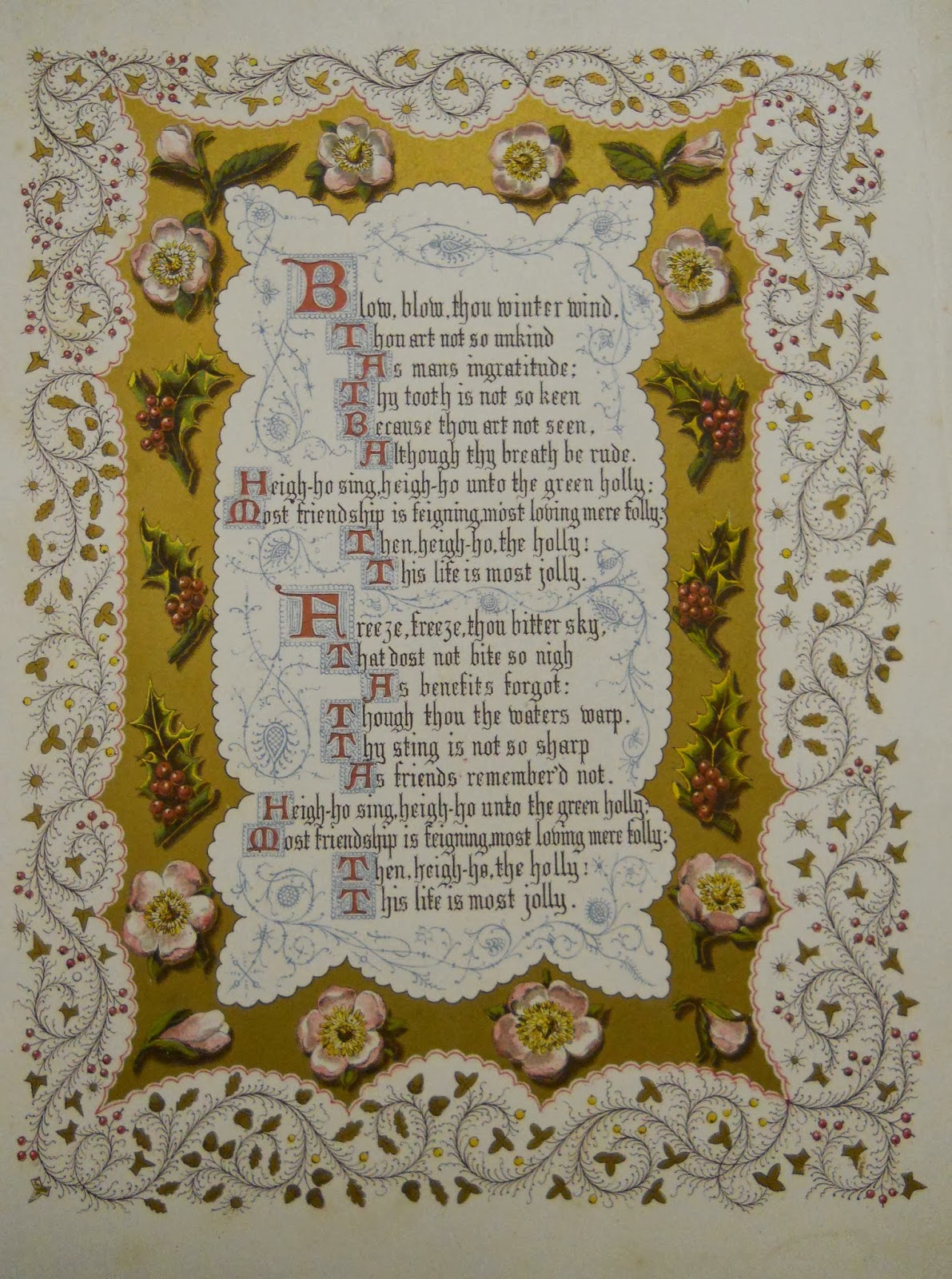 Shakespeare was, of course, a poet as well as a playwright. The earliest version of his poems available in the Brandeis collection was published in 1710, almost a century after his plays were released to the public, and includes the poetry only as a supplement to a compilation of the plays [21]. For Shakespeare scholars it can be exhilarating to read the original dedication to Henry Wriothsley, a figure many suspect to be the object of his love poems [22]. Many poems in the works represented in the Brandeis collection are given titles, most likely as an addition of the editor, whereas in today’s compilations they are referred to simply by numbers. The lack of complexity of the titles to some intricate poems (“Love-sick,” “Familiarity breeds contempt,” etc.) quickly shows even the most basic scholar that the titles were not penned by the original poet. The collection includes a compilation of the poems, titled Shakespeare’s Songs,that separates each poem on its own page with an intricate and beautifully painted border surrounding each piece [23]. This is one of the rare works from a later date, at a time when supplementary editorial material was common, that present Shakespeare’s words without any context; indeed, it includes not just poems but verses and songs removed from his plays, and without any other influence than the words themselves and the page they occupy.
Shakespeare was, of course, a poet as well as a playwright. The earliest version of his poems available in the Brandeis collection was published in 1710, almost a century after his plays were released to the public, and includes the poetry only as a supplement to a compilation of the plays [21]. For Shakespeare scholars it can be exhilarating to read the original dedication to Henry Wriothsley, a figure many suspect to be the object of his love poems [22]. Many poems in the works represented in the Brandeis collection are given titles, most likely as an addition of the editor, whereas in today’s compilations they are referred to simply by numbers. The lack of complexity of the titles to some intricate poems (“Love-sick,” “Familiarity breeds contempt,” etc.) quickly shows even the most basic scholar that the titles were not penned by the original poet. The collection includes a compilation of the poems, titled Shakespeare’s Songs,that separates each poem on its own page with an intricate and beautifully painted border surrounding each piece [23]. This is one of the rare works from a later date, at a time when supplementary editorial material was common, that present Shakespeare’s words without any context; indeed, it includes not just poems but verses and songs removed from his plays, and without any other influence than the words themselves and the page they occupy.
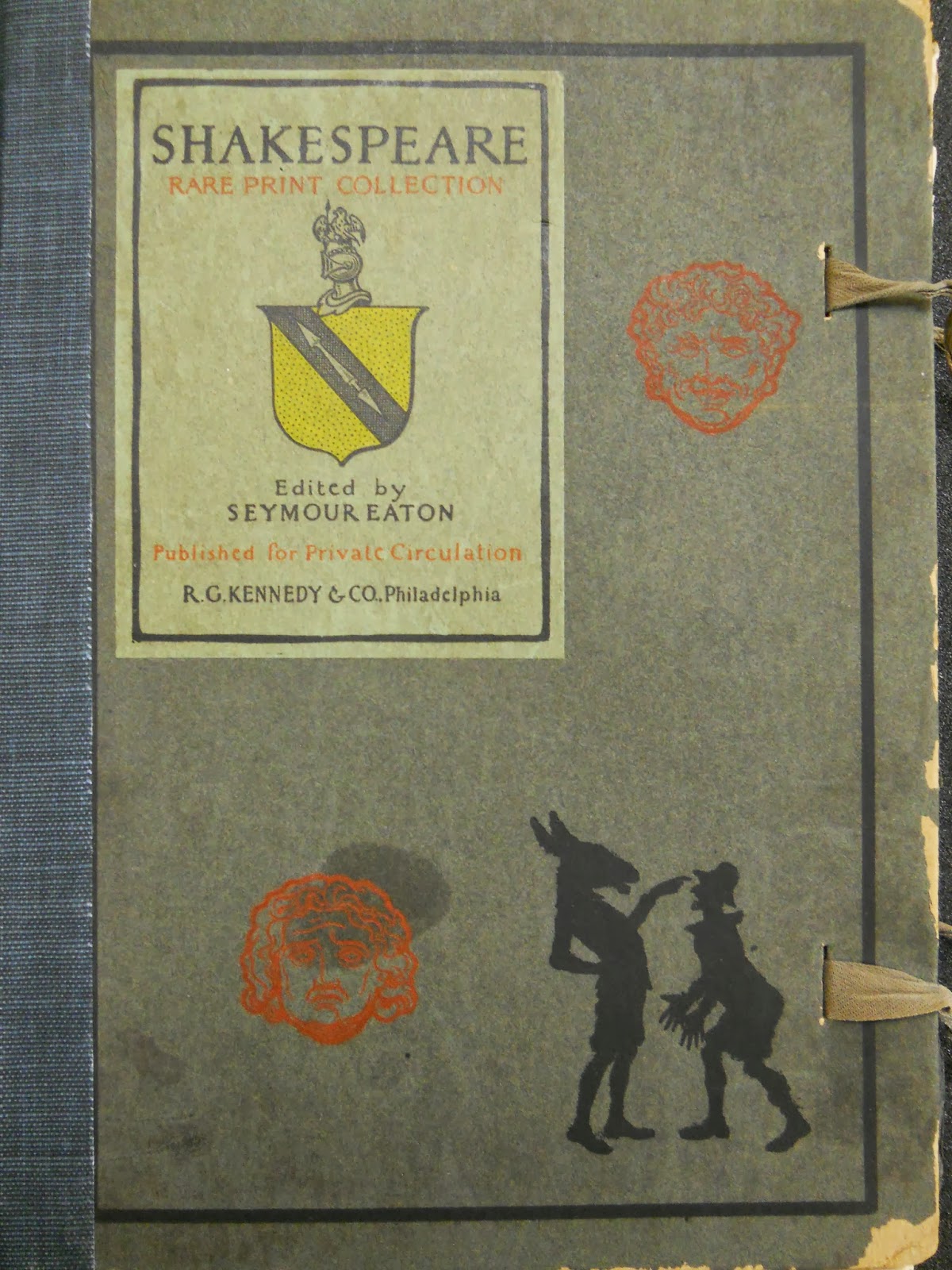 The Shakespeare Collection does not just contain literary texts, but also includes a Shakespeare Rare Print Collection, published in 1900, a compilation of twelve portfolios of artwork inspired by, related to, and even of the author himself [24]. The “Connoisseur’s Edition” was available only to subscribers of a particular literary publication, the Eversley Shakespeare and Review of Reviews, and expressly meant for “private collection.” The idea of an “elite version” of texts, as well as that of a Shakespeare community, demonstrates his continued importance over time, as well as his constant presence in the literary scene. The prints themselves are remarkably varied: some are artistic interpretations of scenes from Shakespeare’s plays; some depict scenery relevant to his life; some are portraits of the playwright, of historical figures included in his works, of Shakespearian actors, of actors in the middle of enacting a scene, of actors as their characters; some are diagrams of Old English theaters, or advertisements for various worldwide showings of the plays. Some are intensely realistic while others are cartoonish; some are black and white while others are brilliantly colored with vivid borders; some include relevant text while some share a page with another image.
The Shakespeare Collection does not just contain literary texts, but also includes a Shakespeare Rare Print Collection, published in 1900, a compilation of twelve portfolios of artwork inspired by, related to, and even of the author himself [24]. The “Connoisseur’s Edition” was available only to subscribers of a particular literary publication, the Eversley Shakespeare and Review of Reviews, and expressly meant for “private collection.” The idea of an “elite version” of texts, as well as that of a Shakespeare community, demonstrates his continued importance over time, as well as his constant presence in the literary scene. The prints themselves are remarkably varied: some are artistic interpretations of scenes from Shakespeare’s plays; some depict scenery relevant to his life; some are portraits of the playwright, of historical figures included in his works, of Shakespearian actors, of actors in the middle of enacting a scene, of actors as their characters; some are diagrams of Old English theaters, or advertisements for various worldwide showings of the plays. Some are intensely realistic while others are cartoonish; some are black and white while others are brilliantly colored with vivid borders; some include relevant text while some share a page with another image.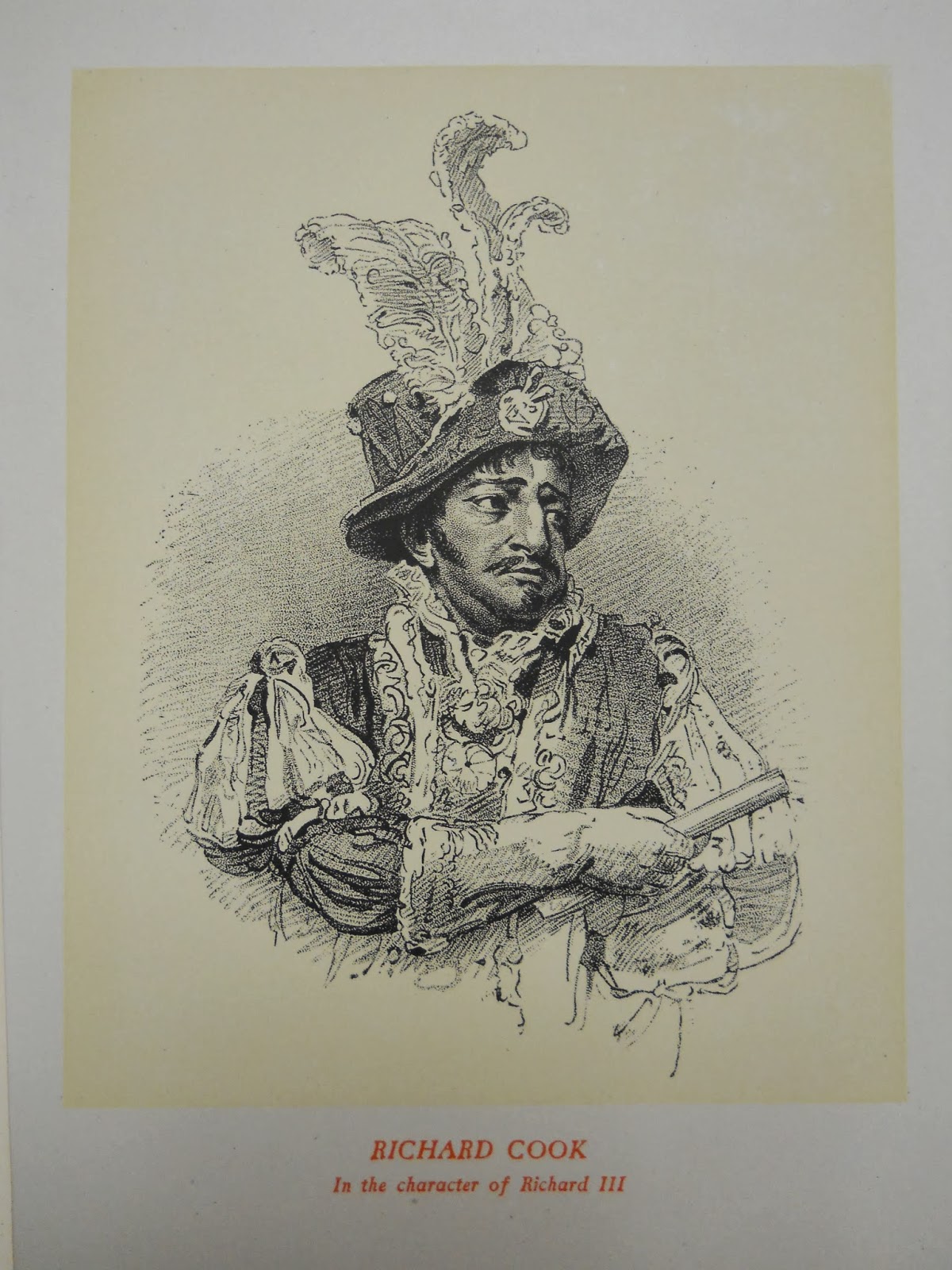 The mix of historical and fictional imagery blurs the lines of reality and art in a way that reflects the verisimilitude of the texts themselves. Indeed, some Shakespearian versions of historical events, such as the death of Julius Caesar, have eclipsed the true versions in a way not seen until Walt Disney replaced the Brothers Grimm in the world of the fairy tale. These prints offer an opportunity for research into the visual aspects of Shakespeare’s work and world. While the work was published in 1900, the dates on the prints range back to Shakespeare’s own time period; much in the way that the Folios and other collections offer valuable compilations of the text, this work preserves an expanse of Shakespearian pictorial resources all in one collection.
The mix of historical and fictional imagery blurs the lines of reality and art in a way that reflects the verisimilitude of the texts themselves. Indeed, some Shakespearian versions of historical events, such as the death of Julius Caesar, have eclipsed the true versions in a way not seen until Walt Disney replaced the Brothers Grimm in the world of the fairy tale. These prints offer an opportunity for research into the visual aspects of Shakespeare’s work and world. While the work was published in 1900, the dates on the prints range back to Shakespeare’s own time period; much in the way that the Folios and other collections offer valuable compilations of the text, this work preserves an expanse of Shakespearian pictorial resources all in one collection.
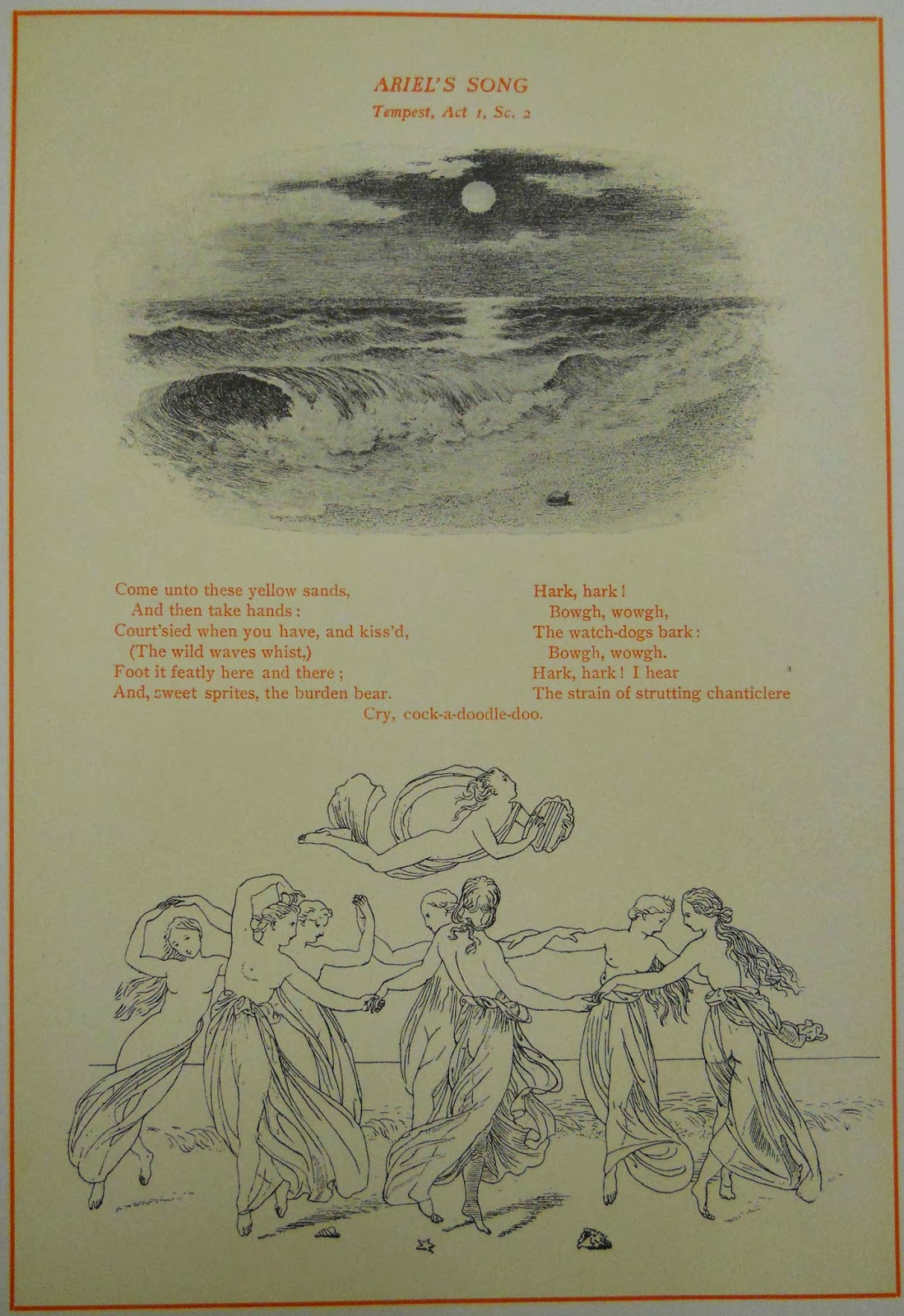 A visit to the Robert D. Farber University Archives and Special Collections Department at Brandeis University offers a multitude of intellectual and academic opportunities for Shakespeare, literary, theater, and Renaissance enthusiasts alike. One can explore the various versions of a single text, discover the reception scholarship across the centuries, or compare unique elements in unconventional ways. The rarity and quality of these works alone would make the Shakespeare collection stand out, but the amount and breadth of topics covered signifies the truly magnificent nature of this scholarly collection.
A visit to the Robert D. Farber University Archives and Special Collections Department at Brandeis University offers a multitude of intellectual and academic opportunities for Shakespeare, literary, theater, and Renaissance enthusiasts alike. One can explore the various versions of a single text, discover the reception scholarship across the centuries, or compare unique elements in unconventional ways. The rarity and quality of these works alone would make the Shakespeare collection stand out, but the amount and breadth of topics covered signifies the truly magnificent nature of this scholarly collection.
Find digitized versions of many of the pieces from the Shakespeare collection on the Internet Archive
Notes
- “The Shakespeare First Folio.” Folger Shakespeare Library. The Folger Shakespeare Library, n.d. Web. 24 Aug. 2013. .
- Shakespeare, William. Mr. William Shakespeares Comedies, Histories & Tragedies : Published According to the True Originall Copies. London: Isaac Jaggard and Ed Blount, 1623.
- Shakespeare, William. The Norton Shakespeare. 1st ed. New York: W. W. Norton, 1997.
- ibid.
- ibid.
- Shakespeare, William. K. Henry IV : With the Humours of Sir John Falstaff ; a Tragi-comedy ; as It Is Acted at the Theatre in Little-Lincolns-Inn-Fields by His Majesty’s Servants ; Revived, with Alterations. Ed. Thomas Betterton. London: Printed for R. W. and Sold by J. Deeve, 1700.
- Shakespeare, William. Mr. William Shakespeares Comedies, Histories & Tragedies : Published According to the True Originall Copies. London: Isaac Jaggard and Ed Blount, 1623. Print, and Shakespeare, William. Hamlet : First Quarto, 1603. London: Shakespeare Associatio, 1951.
- Shakespeare, William. Mr. William Shakespeares Comedies, Histories & Tragedies : Published According to the True Originall Copies. London: Isaac Jaggard and Ed Blount, 1623.
- Shakespeare, William. The Works of Mr. William Shakespear : In Six Volumes. Adorn’d with Cuts / Revis’d and Corrected, with an Account of the Life and Writings of the Author ; by N. Rowe, Esq;. Ed. Nicholas Rowe. London: Printed for Jacob Tonson ..., 1709.
- Shakespeare, William, and Mr. Theobald. Double Falshood; Or, The Distrest Lovers. A Play, as It Is Acted at the Theatre-Royal in Drury-Lane. London: Printed by J. Watts, 1728.
- Shakespeare, William. The Norton Shakespeare. 1st ed. New York: W. W. Norton, 1997.
- ibid.
- ibid. and Shakespeare, William, and Mr. Theobald. Double Falshood; Or, The Distrest Lovers. A Play, as It Is Acted at the Theatre-Royal in Drury-Lane. London: Printed by J. Watts, 1728.
- Shakespeare, William. [Works]. Ed. Alexander Pope. London: Printed for J. Tonson, and the Rest of the Proprietors, 1734.
- Shakespeare, William. The Works of Shakespear : In Six Volumes / Carefully Revised and Corrected by the Former Editions. London: Printed for J. and P. Knapton,... [et Al.], 1745.
- Shakespeare, William. The Works of Shakespeare : In Eight Volumes, Collated with the Oldest Copies, and Corrected: With Notes, Explanatory, and Critical. Comp. Mr. Theobald. 2nd ed. London: Printed for H. Lintott [etc.], 1740.
- Shakespeare, William. The Works of Shakespear : In Six Volumes / Carefully Revised and Corrected by the Former Editions. London: Printed for J. and P. Knapton,... [et Al.], 1745.
- Dodd, WIlliam. The Beauties of Shakespear, Regularly Selected from Each Play : With a General Index, Digesting Them under Proper Heads : Illustrated with Explanatory Notes, and Similar Passages from Ancient and Modern Authors. London: Printed for T. Waller, at the Mitre and Crown ..., 1752.
- Shakespeare, William. A Concordance to Shakespeare: Suited to All the Editions, in Which the Distinguished and Parallel Passages in the Plays of That Justly Admired Writer Are Methodically Arranged. To Which Are Added, Three Hundred Notes and Illustrations, Entirely New. London: G. G. J. and J. Robinson, 1787.
- Grey, Zachaery. Critical, Historical, and Explanatory Notes on Shakespeare, with Emendations of the Text and Metre. Printed for the Author and Sold by R. Manby: London, 1754.
- Shakespeare, William. The Works of Mr. William Shakespear. Volume the Seventh : Containing, Venus & Adonis, Tarquin & Lucrece and His Miscellany Poems. With Critical Remarks on His Plays, &c. to Which Is Prefix’d An Essay on the Art, Rise and Progress of the Stage in Greece, Rome and England. Comp. Charles Golden and Nicholas Rowe. London: Printed for E. Curll ... and E. Sanger ..., 1710.
- ibid.
- Shakespeare, William. Songs of Shakespeare. Ed. H.C. Hoskyns Abrahall. London: Day, 1860.
- Eaton, Seymour, ed. Shakespeare Rare Print Collection. 1900. Philadelphia: R.G. Kennedy & Co.